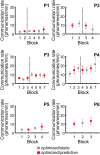Optimized and Predictive Phonemic Interfaces for Augmentative and Alternative Communication
- PMID: 31306607
- PMCID: PMC6808364
- DOI: 10.1044/2019_JSLHR-S-MSC18-18-0187
Optimized and Predictive Phonemic Interfaces for Augmentative and Alternative Communication
Abstract
Purpose We empirically assessed the results of computational optimization and prediction in communication interfaces that were designed to allow individuals with severe motor speech disorders to select phonemes and generate speech output. Method Interface layouts were either random or optimized, in which phoneme targets that were likely to be selected together were located in proximity. Target sizes were either static or predictive, such that likely targets were dynamically enlarged following each selection. Communication interfaces were evaluated by 36 users without motor impairments using an alternate access method. Each user was assigned to 1 of 4 interfaces varying in layout and whether prediction was implemented (random/static, random/predictive, optimized/static, optimized/predictive) and participated in 12 sessions over a 3-week period. Six participants with severe motor impairments used both the optimized/static and optimized/predictive interfaces in 1-2 sessions. Results In individuals without motor impairments, prediction provided significantly faster communication rates during training (Sessions 1-9), as users were learning the interface target locations and the novel access method. After training, optimization acted to significantly increase communication rates. The optimization likely became relevant only after training when participants knew the target locations and moved directly to the targets. Participants with motor impairments could use the interfaces with alternate access methods and generally rated the interface with prediction as preferred. Conclusions Optimization and prediction led to increases in communication rates in users without motor impairments. Predictive interfaces were preferred by users with motor impairments. Future research is needed to translate these results into clinical practice. Supplemental Material https://doi.org/10.23641/asha.8636948.
Figures






Similar articles
-
Effects of a Conversation-Based Intervention on the Linguistic Skills of Children With Motor Speech Disorders Who Use Augmentative and Alternative Communication.J Speech Lang Hear Res. 2017 Jul 12;60(7):1980-1998. doi: 10.1044/2016_JSLHR-L-15-0246. J Speech Lang Hear Res. 2017. PMID: 28672283 Free PMC article.
-
Surface electromyographic control of a novel phonemic interface for speech synthesis.Augment Altern Commun. 2016 Jun;32(2):120-30. doi: 10.3109/07434618.2016.1170205. Epub 2016 May 4. Augment Altern Commun. 2016. PMID: 27141992 Free PMC article.
-
A nonverbal phoneme deletion task administered in a dynamic assessment format.J Commun Disord. 2011 Mar-Apr;44(2):236-45. doi: 10.1016/j.jcomdis.2010.11.003. Epub 2010 Nov 25. J Commun Disord. 2011. PMID: 21168145
-
Brain-Computer Interfaces for Augmentative and Alternative Communication: A Tutorial.Am J Speech Lang Pathol. 2018 Feb 6;27(1):1-12. doi: 10.1044/2017_AJSLP-16-0244. Am J Speech Lang Pathol. 2018. PMID: 29318256 Free PMC article. Review.
-
Augmentative and Alternative Communication (AAC) Advances: A Review of Configurations for Individuals with a Speech Disability.Sensors (Basel). 2019 Apr 22;19(8):1911. doi: 10.3390/s19081911. Sensors (Basel). 2019. PMID: 31013673 Free PMC article. Review.
Cited by
-
Ability-based Keyboards for Augmentative and Alternative Communication: Understanding How Individuals' Movement Patterns Translate to More Efficient Keyboards: Methods to Generate Keyboards Tailored to User-specific Motor Abilities.Ext Abstr Hum Factors Computing Syst. 2022 Apr;2022:412. doi: 10.1145/3491101.3519845. Epub 2022 Apr 28. Ext Abstr Hum Factors Computing Syst. 2022. PMID: 36287777 Free PMC article.
-
Ability-Based Methods for Personalized Keyboard Generation.Multimodal Technol Interact. 2022 Aug;6(8):67. doi: 10.3390/mti6080067. Epub 2022 Aug 3. Multimodal Technol Interact. 2022. PMID: 36313956 Free PMC article.
References
-
- Anton F., Mioc D. & Gold C. M. (1998). Dynamic additively weighted Voronoi diagrams made easy. In Canadian Conference on Computational Geometry (CCCG).
-
- Bates D., Mächler M., Bolker B., & Walker S. (2015). Fitting linear mixed-effects models using lme4. Journal of Statistical Software, 67(1), 1–48. https://doi.org/10.18637/jss.v067.i01
-
- Beddoes M. P., & Hu Z. (1994). A chord stenograph keyboard: A possible solution to the learning problem in stenography. IEEE Transactions on Systems, Man, and Cybernetics, 24(7), 953–960. https://doi.org/10.1109/21.297785
-
- Beukelman D. R., Fager S. K., Ball L., & Dietz A. (2007). AAC for adults with acquired neurological conditions: A review. Augmentative and Alternative Communication, 23(3), 230–242. https://doi.org/10.1080/07434610701553668 - PubMed
-
- Beukelman D. R., & Gutmann M. (1999). Generic message list for AAC users with ALS. Lincoln: University of Nebraska–Lincoln; Retrieved from https://cehs.unl.edu/documents/secd/aac/vocablists/ALS_Message_List1.pdf
Publication types
MeSH terms
Grants and funding
LinkOut - more resources
Full Text Sources
Medical

